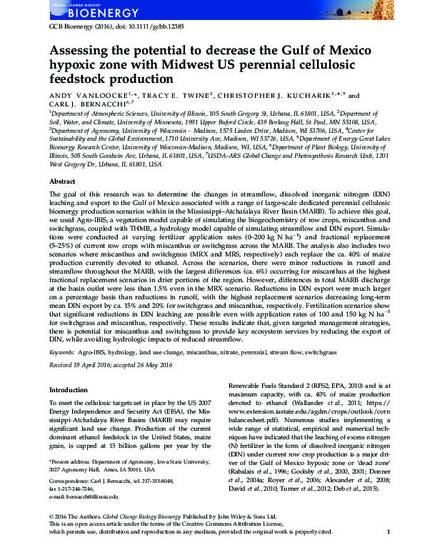
The goal of this research was to determine the changes in streamflow, dissolved inorganic nitrogen (DIN) leaching and export to the Gulf of Mexico associated with a range of large-scale dedicated perennial cellulosic bioenergy production scenarios within in the Mississippi–Atchafalaya River Basin (MARB). To achieve this goal, we used Agro-IBIS, a vegetation model capable of simulating the biogeochemistry of row crops, miscanthus and switchgrass, coupled with THMB, a hydrology model capable of simulating streamflow and DIN export. Simulations were conducted at varying fertilizer application rates (0–200 kg N ha -1) and fractional replacement (5–25%) of current row crops with miscanthus or switchgrass across the MARB. The analysis also includes two scenarios where miscanthus and switchgrass (MRX and MRS, respectively) each replace the ca. 40% of maize production currently devoted to ethanol. Across the scenarios, there were minor reductions in runoff and streamflow throughout the MARB, with the largest differences (ca. 6%) occurring for miscanthus at the highest fractional replacement scenarios in drier portions of the region. However, differences in total MARB discharge at the basin outlet were less than 1.5% even in the MRX scenario. Reductions in DIN export were much larger on a percentage basis than reductions in runoff, with the highest replacement scenarios decreasing long-term mean DIN export by ca. 15% and 20% for switchgrass and miscanthus, respectively. Fertilization scenarios show that significant reductions in DIN leaching are possible even with application rates of 100 and 150 kg N ha -1 for switchgrass and miscanthus, respectively. These results indicate that, given targeted management strategies, there is potential for miscanthus and switchgrass to provide key ecosystem services by reducing the export of DIN, while avoiding hydrologic impacts of reduced streamflow.
Available at: http://works.bepress.com/andy_vanloocke/19/

This is an article from Global Change Biology: Bioenergy (2016): doi:10.1111/gcbb.12385. Posted with permission.